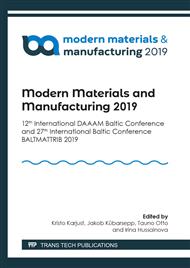[1]
Z.Z. Ismail, E.A. Al-Hashmi, Use of waste plastic in concrete mixture as aggregate replacement, Waste Manag. 28 (2008) 2041-2047.
DOI: 10.1016/j.wasman.2007.08.023
Google Scholar
[2]
M.T. Carvalho, N. Dias, P. Brogueira, Separation by particle shape – the RecGlass device, Int. J. Miner. Process. 140 (2015) 1-7.
DOI: 10.1016/j.minpro.2015.04.016
Google Scholar
[3]
J. Jasaitienė, E. Ivanauskas, M. Daukšys, Investigation of lightweight concrete with porous aggregates, in: Proc. of the 2nd Int. Conf. Advanced Construction 2010, Kaunas, 2010, 122-128.
Google Scholar
[4]
M. Limbachiya, M. Meddah, S. Fotiadou, Performance of granulated foam glass concrete, Constr. Build. Mater. 28 (2012) 759-768.
DOI: 10.1016/j.conbuildmat.2011.10.052
Google Scholar
[5]
R. Yu, D.V. van Onna, P. Spiesz, Q.L. Yu, H.J.H. Brouwers, Development of ultra-lightweight Fibre Reinforced Concrete applying expanded waste glass, J. Clean. Prod. 112 (2016) 690-701.
DOI: 10.1016/j.jclepro.2015.07.082
Google Scholar
[6]
P. Spiesz, Q.L. Yu, H.J.H. Brouwers, Development of cement-based lightweight composites – Part 2: Durability-related properties, Cem. Concr. Comp. 44 (2013) 30-40.
DOI: 10.1016/j.cemconcomp.2013.03.029
Google Scholar
[7]
G. Bumanis, D. Bajare, A. Korjakins, Mechanical and thermal properties of lightweight concrete made from expanded glass, J.Sustain. Architecture Civil Eng. 2 (2013) 26-32.
DOI: 10.5755/j01.sace.2.3.2790
Google Scholar
[8]
J.M. Chi, R. Huang, C.C. Yang, J.J. Chang, Effects of aggregate properties on the strength and stiffness of lightweight concrete, Cem. Concr. Comp. 25 (2003) 197-205.
DOI: 10.1016/s0958-9465(02)00020-3
Google Scholar
[9]
A. Arulrajah, M.M. Disfani, F. Maghoolpilehrood, S. Horpibulsuk, A. Udonchai, M. Imteaz, Y. Du, Engineering and environmental properties of foamed recycled glass as a lightweight engineering material, J. Clean. Prod. 94 (2015) 369-375.
DOI: 10.1016/j.jclepro.2015.01.080
Google Scholar
[10]
B.L.A. Tuan, C.L. Hwang, K.L. Lin, Y.Y. Chen, M.P. Young, Development of lightweight aggregate from sewage sludge and waste glass powder for concrete, Constr. Build. Mater. 47 (2013) 334-339.
DOI: 10.1016/j.conbuildmat.2013.05.039
Google Scholar
[11]
A.L. Brooks, H. Zhou, D. Hanna. Comparative study of the mechanical and thermal properties of lightweight cementitious composites, Constr. Build. Mater. 159 (2018) 316-328.
DOI: 10.1016/j.conbuildmat.2017.10.102
Google Scholar
[12]
A. Laukaitis, R. Žurauskas, J. Kerienė, The effect of foam polystyrene granules on cement composite properties, Cem. Concr. Comp. 27 (2005) 41-47.
DOI: 10.1016/j.cemconcomp.2003.09.004
Google Scholar
[13]
A. Allahverdi, S.A. Azimi, M. Alibabaie, Development of multi-strength grade green lightweight reactive powder concrete using expanded polystyrene beads, Constr. Build. Mater. 172 (2018) 457-467.
DOI: 10.1016/j.conbuildmat.2018.03.260
Google Scholar
[14]
J. Šeputytė-Jucikė, M. Sinica, The effect of expanded glass and polystyrene waste on the properties of lightweight aggregate concrete, Eng. Struct. Tech. 8 (2016) 31-40.
DOI: 10.3846/2029882x.2016.1162671
Google Scholar
[15]
G. Bumanis, D. Bajare, J. Locs, A. Korjakins, Alkali-silica reactivity of foam glass granules in structure of lightweight concrete, Constr. Build. Mater. 47 (2013) 274–281.
DOI: 10.1016/j.conbuildmat.2013.05.049
Google Scholar
[16]
T.Y. Lo, W.C. Tang, H.Z. Cui, The effects of aggregate properties on lightweight concrete, Build. Environ. 42 (2007) 3025-3029.
DOI: 10.1016/j.buildenv.2005.06.031
Google Scholar
[17]
N. Saikia, J.D. Brito, Use of plastic waste as aggregate in cement mortar and concrete preparation: A review, Constr. Build. Mater. 34 (2012) 385-401.
DOI: 10.1016/j.conbuildmat.2012.02.066
Google Scholar
[18]
X. Liu, K.S. Chia, M.H. Zhang, Development of lightweight concrete with high resistance to water and chloride-ion penetration, Cem. Concr. Comp. 32 (2010) 757-766.
DOI: 10.1016/j.cemconcomp.2010.08.005
Google Scholar
[19]
R.V. Silva, J. de Brito, N. Saikia, Influence of curing conditions on the durability-related performance of concrete made with selected plastic waste aggregates, Cem. Concr. Comp. 35 (2013) 23-31.
DOI: 10.1016/j.cemconcomp.2012.08.017
Google Scholar


